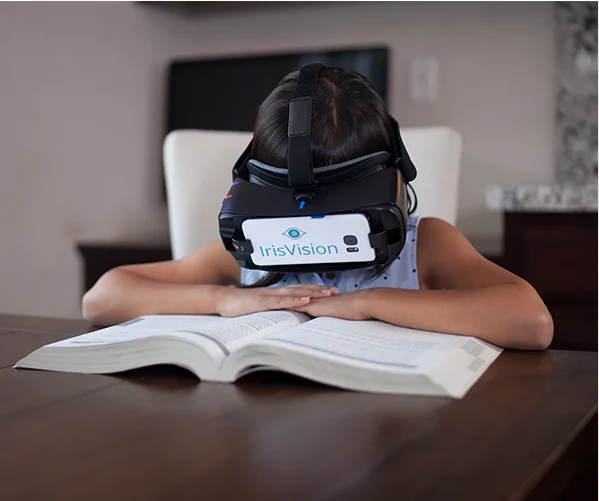Share
Last updated: October 24, 2022
Low Vision Aids are devices designed to help people with poor vision read and see. Examples include standing and hand-held magnifiers, strong magnifying reading glasses, loupes, and small telescopes. These devices provide greatly increased magnification capabilities along with higher-quality optics (i.e. the way the lens bends or refracts light). Often prescribed by an eye doctor, these devices are different from your normal eyesight glasses and magnifiers.
The IrisVision is a complete Low Vision solution. It goes beyond simple magnification and higher resolution. We have designed it to give a visually impaired person a second chance at life.

IrisVision is the world’s most advanced Low Vision Aids, in the form of a wearable headset. More than a headset—IrisVision is a medical-grade device that enhances and optimizes vision.
With the widest field of view, a range of amazing reading modes and a crisp picture quality, IrisVision helps visually impaired people regain what was lost! The ability to see clearly and live fully.
Looking at conventional options for low vision aids, you either go for Electronic low vision aids or Optical/Magnifying low vision aids. Every other visually impaired product can aid in only one or two specific tasks. It takes a number of low vision aids products to match up with the capabilities and features IrisVision brings to the table.

Closed Circuit Television (CCTV) Video Magnifiers
Bulky machines, must be plugged in all the time, not portable and cost $3000 on average.
Lighter than CCTVs but tiresome to use. A smaller display with a narrow focal range.
Magnifying glasses and telescopic devices come with the same drawbacks. A fixed range and a limited field of view, intended to view one object at a time.
Low vision aids research has shown that it is common for a patient to own 6 to 8 different devices to accomplish all the tasks necessary for daily living. This could include a low vision magnifying glass for spot reading, a low vision portable electronic magnifier for reading mail or setting a wall thermostat, a low vision aids desktop CCTV to read magazines or books, and several low vision distance devices for watching TV or entertainment outings.
You could count that or get 1 low vision aid to replace them all. IrisVision low vision glasses can do everything these products can, and that too, with added comfort, features and a very convenient price.
IrisVision low vision glasses harnesses groundbreaking technology into a single, hands-free device to help with many daily tasks needed by those who live with a vision impairment. It boasts an extra large LED screen with an expansive field of view and a powerful camera with auto-focus capabilities.
Our thought leaders and experts tailored IrisVision to cater to many eye diseases and still be able to give an individualized experience. Handy features, top of the line performance and that too at an affordable price!

Empowers you or your loved ones to see and interact with their environment more effectively. IrisVision’s headset leads the industry with a 70-degree field of view, giving users the clearest picture possible.

Wear IrisVision comfortably indoors and outdoors thanks to a hands-free, portable design. The extended and bubble views make it easy to transition from different lighting environments.

Read books, magazines, newspapers, and more in high-contrast black and white or inverted B&W mode. B&W text absorbs the light that hits each word, reducing stress on reader’s eyes— especially for those bothered by bright lights.

Use TV mode in IrisVision Low Vision Glasses to watch television or view other screens like mobile devices and laptops. Plus, easily switch to scene mode for general viewing. Multiple view modes give IrisVision users the flexibility to see with the vision that is best suited for any given environment.

Magnify points of interest while keeping the overall scene in context with IrisBubble. IrisBubble, IrisVision’s bubble view, avoids the “telescope” effect that brings a subject into focus but blurs the overall scene. IrisBubble focus can even be repositioned and shaped to the user’s liking.

Adjust light levels, contrast, and IPD (interpupillary distance). Ambient level control optimizes comfort. Contrast enhancement and correction compensates for contrast loss. IrisVision also allows users to adjust IPD for optimal clarity.
Get a 30-day evaluation for yourself, a patient, or a loved one. Or if you’re ready for IrisVision Live, get started now.
Our team of trained Low Vision aids agents will provide detailed walkthroughs and tutorials on how to use the device. We work with our customers to provide maximum support and comfort in learning how to use IrisVision.
Our team of trained Low Vision aids agents will provide detailed IrisVision shares rehabilitation procedures and techniques from experts via software, training programs, and specialists, so visually impaired people can integrate back in their society and live independently as soon as possible. walkthroughs and tutorials on how to use the device. We work with our customers to provide maximum support and comfort in learning how to use IrisVision.
We recognize the important job caretakers perform. That is why IrisVision offers training and guidance programs for people providing care to low-vision patients.
Get your IrisVision today and experience low vision aids like never before. Contact us at IrisVision or drop us a message, and our technology experts will assist any query you have.
#SeeClearlyLiveFully
Low vision aids are visual solutions aimed at expediting your leftover vision to help you perform your daily activities with added ease and convenience, a liberty taken away from you by your receding vision.
Different types of such devices are available in the market right now. For instance, optical and non-optical aids present you with relatively simple and inexpensive solutions to aid your visual capability. Then there are devices like electronic and digital magnifiers, which are slightly advanced as well as expensive.
You need a certain level of training to efficiently use both optical as well as non-optical/electronic devices. In fact, experts believe training to be the major factor in determining how successfully you are able to use such low vision devices.
Low vision devices can be categorized as optical vision aids, non-optical vision aids, electronic magnifiers and magnifying systems. These are specialized task-oriented devices designed to help people with either close-up tasks or distance viewing. This indicates that you may need more than one of such devices to undertake a specific task depending upon the condition of your eye and the type of daily routine you follow; for example, you’ll be needing a different type of conventional low vision aid to use your computer at home, school or office, whereas you’ll need to rely on the other when you’d be reading a menu in a restaurant.
Let’s see the major types of aids for low vision:
A large array of visual aids constitutes low vision optical devices, such as handheld and stand magnifiers, loupes, specialized magnifying reading glasses and small telescopes. These are not your average glasses and magnifiers available in local stores or online. These offer significantly raised magnification powers in addition to their enhanced quality optics (i.e. their capability of bending and refracting light), which makes them so beneficial for people suffering from low vision. In most cases, you require specific training to be able to use them appropriately.
As the name suggests, low vision non-optical devices are different from the optical ones, comprising of adaptations like reading stands, glare control sunglasses, tactile locator dots and typoscopes. When used with optical devices for low vision, these devices can offer considerable help in reading, labeling, organizing and a host of other daily activities.
You can get these in a range of sizes and styles, depending upon the type of task you want to perform. Some feature a camera system that magnifies and displays an image on a monitor, offering assistance in reading books, magazines and emails. These are commonly known as cctv low vision aids. To cater portability, there are other handheld electronic magnifying systems you may also carry with you to supermarkets for reading labels and coupons, or in restaurants for reading menus.
Yes, there’s one. Though it sounds quite unlikely, but IrisVision is one-of-a-kind low vision solution that alleviates the need of all these different types of low vision aids. This has become possible by merging the best of two different domains, i.e. eye care industry and mobile phones industry, and the rest is history. Let’s see how this device offers the features contained in different types of low vision devices in a single place.
Reading is one of the most affected areas of people suffering from different types of low vision issues. Some face problems in seeing objects close by, while some other conditions make it difficult for people to see far off objects, as a result of which different types of conventional low vision devices catering to these different needs were developed.
However, with IrisVision at your disposal, you don’t need to have different devices to compensate for different visual shortcomings. It offers you a host of different reading modes designed to assist in different scenarios. Let’s have a look at them:
This mode offers you reading material with a white background featuring black letters, best for reading text material from books or papers without color. Sometimes one has to read from surfaces having the text and background colors that make it difficult to read; for example, pink text on red background or beige text on brown background. This mode best serves such instances.
Again, this is how this innovative device eliminates the need of multiple devices to assist in different vision-hampering scenarios. With reading line mode, you get a virtual magnification bar in the center of the screen, magnifying one or more lines of text at the center of the bar, while featuring normal view of the scene above and below it. Features like this make IrisVision one of the best low vision aids for reading.
With this reading mode, you get black reading text against a green background. Many people suffering from specific vision issues find it to be a better contrast, not having to bear the brightness of a white background.
You get reading text in black against a yellow background with this mode, another useful way of increasing contrast without the brightness of a white background. People find it most helpful when they have to read for extended time periods.
Also known as video magnifiers, cctv low vision aids come in many sizes and shapes with a host of features aimed at helping people with low vision get a magnified and enhanced vision of their desired objects. With all variations in sizes, shapes and features, one thing remains common in these cctv low vision aids, a camera that captures an image and returns it magnified onto a monitor, which can be anything from a small tablet to quite a big TV screen.
IrisVision takes the concept of cctv low vision aids to the next level by surpassing the need to carry along different monitors. You simply strap the headgear on, with a high resolution camera faced outwards, which serves to capture the scene for you and returns it processed and magnified in real-time, customized to the specific needs and requirements of different types of low vision conditions.
With conventional low vision devices, portability meant taking either optical low vision magnifiers or handheld electronic magnifying systems to places like shops and restaurants and reading menus, list and other items using those. That means having a totally different type of electronic magnifying system to use your compute or laptop at home, while having to bring another handheld version when going shopping. However, IrisVision offers you true portability, getting you totally hands-free whether you’re home using your computer or out in the grocery store looking for your favorite crisps. You just need to strap on the IrisVision console around your eyes and you’re ready to go everywhere without the need to switch between various low vision devices, justifying IrisVision’s place on top of all wearable low vision aids.
People suffering from age related macular degeneration (also known as AMD or ARMD) have their central vision affected by the disease, while their peripheral vision or side vision continues to function better for a much longer period of time.
IrisVision glasses serve as the best low vision aid for macular degeneration, because these enable you to shrink the whole image captured by the camera lens to a much smaller area, which can be moved around across your field of vision (FOV), expediting your leftover vision like no other low vision aids.
This means you can still view the faces of your loved ones by moving the image to your peripheral vision though your central vision fails to pick it up.
Similarly, different types of glaucoma affect peripheral vision primarily, resulting in peripheral vision loss or tunnel vision, shrinking your field of view from around the outer edges of the retina.
For all those searching for the best low vision aids for glaucoma patients, nothing beats the IrisVision, as its ‘RP Mode’ not only squeezes the whole captured scene to a smaller area, you can move it across to your central vision, which gives you better vision despite this disease.
Before you can make up your mind to give IrisVision low vision glasses a try for yourself, you can visit IrisVision customer stories to see how this innovative and futuristic low vision solution has changed the lives of patients suffering from various degenerative eye diseases like AMD, cataracts, retinitis pigmentosa, glaucoma, optic nerve damage, juvenile macular degeneration, Best’s disease, Stargardt’ disease and so forth.
Moreover, you need to realize the significance of regular eye exam, as it gives you the best opportunity to get your eyes assessed for any problems well in time, which is the key factor in treating various degenerative eye diseases. So, make sure you never skip your eye exam.
Let us help you with any questions you have.
Fill out the form below or call us at +1 (855) 449 4536 for your free consultation.